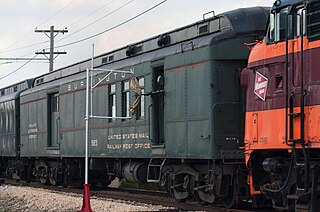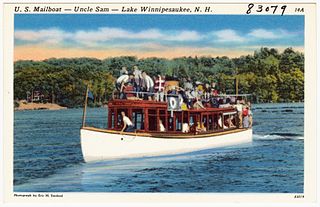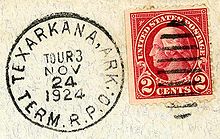The Railway Mail Service of the United States Post Office Department was a significant mail transportation service in the US from the mid-19th century until the mid-20th century. The RMS, or its successor the Postal Transportation Service (PTS), carried the vast majority of letters and packages mailed in the United States from the 1890s until the 1960s.

A postmark is a postal marking made on an envelope, parcel, postcard or the like, indicating the place, date and time that the item was delivered into the care of a postal service, or sometimes indicating where and when received or in transit. Modern postmarks are often applied simultaneously with the cancellation or killer that marks postage stamps as having been used. Sometimes a postmark alone is used to cancel stamps, and the two terms are often used interchangeably. Postmarks may be applied by handstamp or machine, using methods such as rollers or inkjets, while digital postmarks are a recent innovation.

The United States Postal Service (USPS), also known as the Post Office, U.S. Mail, or Postal Service, is an independent agency of the executive branch of the United States federal government responsible for providing postal service in the U.S., including its insular areas and associated states. It is one of the few government agencies explicitly authorized by the U.S. Constitution. The USPS, as of 2021, has 516,636 career employees and 136,531 non-career employees.

The United States Post Office Department was the predecessor of the United States Postal Service, in the form of a Cabinet department, officially from 1872 to 1971. It was headed by the postmaster general.

A ZIP Code is a postal code used by the United States Postal Service (USPS). Introduced on July 1, 1963, the basic format consisted of five digits. In 1983, an extended ZIP+4 code was introduced; it included the five digits of the ZIP Code, followed by a hyphen and four digits that designated a more specific location.

Postal history is the study of postal systems and how they operate and, or, the study of the use of postage stamps and covers and associated postal artifacts illustrating historical episodes in the development of postal systems. The term is attributed to Robson Lowe, a professional philatelist, stamp dealer and stamp auctioneer, who made the first organised study of the subject in the 1930s and described philatelists as "students of science", but postal historians as "students of humanity". More precisely, philatelists describe postal history as the study of rates, routes, markings, and means.

This a survey of the postage stamps and postal history of the Russian Empire, the Soviet Union and the modern Russian Federation.

In Canada and the United States, a railway post office, commonly abbreviated as RPO, was a railroad car that was normally operated in passenger service as a means to sort mail en route, in order to speed delivery. The RPO was staffed by highly trained Railway Mail Service postal clerks, and was off-limits to the passengers on the train. In the UK and Ireland, the equivalent term was travelling post office (TPO).

A Travelling Post Office (TPO) was a type of mail train used in Great Britain and Ireland where the post was sorted en route.
The Railway Mail Service (RMS) Library is a major collection of materials pertaining to en route distribution history. Incorporated in May 2003, it can assist researchers interested in Railway Mail Service, route agent, Seapost, Railway Post Office (RPO), and Highway Post Office (HPO) history. The collection has many unique, original-source documents that provide answers to questions dealing with the transportation and distribution of USA Mail between 1862 and 1977, as well as other countries during the 19th century and 20th century.
An air mail facility is an installation for airmails of the United States.

From the 1880s until well into the 1950s, virtually all long-distance transportation of United States Mail was performed by the railroads. Specially equipped railway post office (RPO) cars were a part of most passenger trains, the cars staffed by highly trained railway postal clerks who sorted mail as the train sped along its route. The growth of this mail distribution network paralleled the expansion of the railroads, allowing mail to be exchanged between routes at junction points where two railroads crossed or shared passenger terminals.

Post was transported over water in the United States in the later nineteenth and the twentieth century.
The Postal Transportation Service (PTS) was the renamed successor to the Railway Mail Service of the United States Post Office Department from 1 October 1949. Although this branch of the service had been in charge of all transit mail, some parts had little to do with railroads, even though they were still the most important part of the service. In 1950, of the 32,000 clerks assigned to the PTS, only about 16,000 actually worked on trains. The remainder were in terminals, transfer offices, Air Mail Facility, Highway Post Offices (HPO), administrative offices, etc. Boat Railway Post Office, Streetcar Railway Post Offices, and the Seapost Service had already been discontinued. The name of the Chief Clerk's office was changed to District Superintendent's office.
The Bureau of Transportation of the United States Post Office Department was established in 1960. It was the successor to the Postal Transportation Service (PTS); the PTS had responsibility for mail transportation contracting as well as employees assigned to Mobile Unit and stationary PTS facilities such as Air Mail Facility, Terminal Railway Post Office, or Transfer Office operations. Only the contract issuance and administration responsibilities for mail routes were given to the Bureau of Transportation. Human Resources were transferred to postmasters in the cities where Mobile and Stationary Units were located. This division of activity continued to the end of the Post Office Department and after it became the U.S. Postal Service.

Russian Post is an Aktsionernoye Obschestvo which is the national postal operator of Russia. The company is responsible for the delivery of mail in Russia, and the issuing of postage stamps. Russian Post employs about 390,000 people and has over 42,000 post offices, with its headquarters in Moscow. In 2012 the Russian Post delivered more than 2.4 billion pieces of mail and accounted for more than 54 million parcels and more than 100 million in remittances. In March 2013 a presidential decree signed by President Vladimir Putin included the Russian Post in a list of so-called strategic enterprises.

Mobile post offices deliver mail and other postal services through specially equipped vehicles, such as trucks and trains.

The postal system of Norway dates from 1647, when Christian IV of Denmark-Norway granted a concession to a private company who established the Postvesenet. The Postvesenet primarily provided a way for various parts of the country to communicate with the central government in Christiania. Although Norway came under rule of the Swedish king in 1815, the postal service remained independent of the Swedish post, and continued to gradually established routes throughout the country.

A mail bag or mailbag is a generic term for a type of bag used for collecting, carrying, categorizing, and classifying different types of postal material, depending on its priority, destination, and method of transport. It is oftentimes used by a post office system in transporting these different grades of mail. The mailbag is carried by some means of transporting like a mail carrier, animal, or a mobile post office. Letters and printed material delivered by mail in the seventeen-hundreds were carried by horse in a saddle bag. There are several different types of mailbags for different purposes. These different styles of mailbags depend on its size and purpose. It can range from "a large bag used for transporting mail on a truck, plane, etc." to a simple "postbag" used by a mail carrier to deliver mail.

The U.S. Parcel Post stamps of 1912–13 were the first such stamps issued by the U.S. Post Office Department and consisted of twelve denominations to pay the postage on parcels weighing 16 ounces and more, with each denomination printed in the same color of "carmine-rose". Their border design was similar while each denomination of stamp bore its own distinctive image in the center (vignette). Unlike regular postage items, whose rates were determined by weight in ounces, Parcel Post rates were determined and measured by increments in pounds. The new stamps were soon widely used by industry, farmers and others who lived in rural areas. Partly owing to some confusion involving their usage, their exclusive use as Parcel Post stamps proved short lived, as regular postage stamps were soon allowed to be used to pay parcel postage rates.















